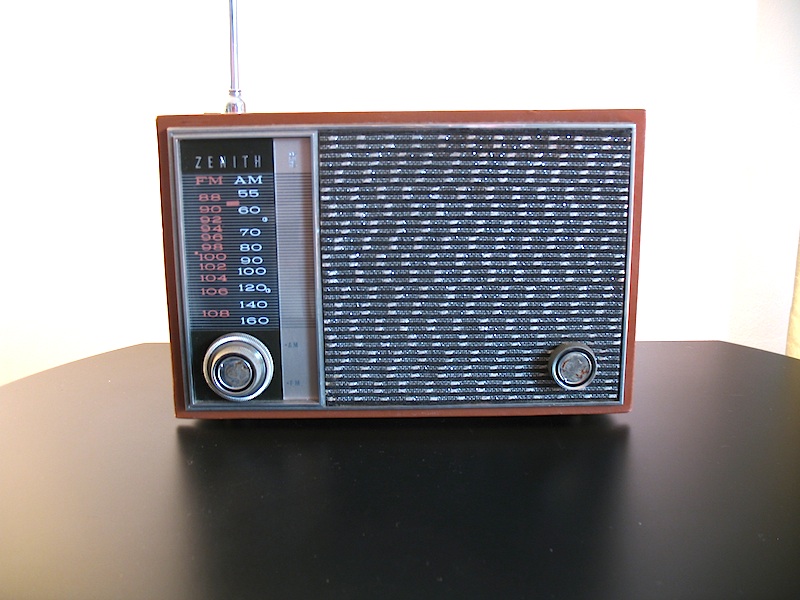
The Zenith Royal 880 was in Zenith's lineup for only a year, but it was the precursor to a broadening line of AM/FM radios, coinciding with the resuscitation of FM after years of difficulty. It was a 1963 model, offered for sale beginning in the fall of 1962.
In 1963, the Zenith Royal 880 cost nearly $90 — in 1963 dollars, of course. The inflation-adjusted equivalent today would be around $660, according to the inflation calculator at the Bureau of Labor Statistics. So this radio was built to last. And is it ever a tank.
It wasn't Zenith's first portable AM/FM radio. An earlier model, the Royal 2000, was on sale at least through 1963, according to a brochure of Zenith radios that I have from that year. That brochure also called the Royal 880, otherwise known as the "Vocalaire", a "music lovers' dream radio, featuring new, high-gain FM transistors plus special Zenith highly stable FM circuity".
It must have been stable: it must have been the only Zenith FM radio I've ever seen that did not have automatic frequency control (AFC). That was a common feature on FM radios through the 1970s, but often indicated poorer-quality FM circuitry in my opinion (though there are exceptions).
Another website confirms that the Royal 880 contained new circuitry. The article, written by former Zenith engineer Dwight Poppy, states that, after some legal back-and-forth, Zenith was able to use an improved RCA design, resulting in "a vast improvement in tuning over the FM detector used in the Royal 2000." Mr. Poppy was also in charge of the design for a later model, the Royal 810. I have a later version of that radio, the Royal 51.
Norman Smith, in his excellent Zenith Transistor Radios: Evolution of a Classic, describes some of the technical features: tuned RF stages on both AM and FM, a hand-wired chassis, and plug-in transistors.
My 1963 brochure indicates that the radio was in a case covered with Zenith "Permawear" material, which often hasn't fared well. The radio that I have is missing its handle but otherwise is in good shape. The case was available either in ebony or in tan.
Keeping in mind that vintage radios are sometimes a little out-of-shape, and also keeping in mind that I'm writing about only one sample, any generalizations to other samples of the same model should be considered carefully.
But, when I was a kid, I remembered that FM radios didn't always perform so well, and, unfortunately, that's the case with this radio.
FM performance, by today's standards, is mediocre. The radio is not selective on FM at all. It's moderately sensitive with the antenna extended, but it's not likely to pick up distant signals. Characteristic of an earlier era of FM radios, the audio level produced by this Zenith is somewhat dependent upon signal strength -- a weak signal is not only noisier, but also heard at a much lower volume. Possibly this indicates that FM-limiter circuits in these radios were not very good (despite the tuned RF stage?). Audio level should be fairly constant for all but the lowest signal strengths in an FM radio, but that's not true here.
The FM antenna, which is really thick by modern standards, extends to the proper length, but doesn"t rotate.
The AM part of the radio is sensitive and moderately selective. Audio response starts rolling off at 4 kHz, just as it does on most other Zenith radios.
I originally got this radio because I was curious about how these mid-century-era FM radios performed. They might have been adequate for a time when there were few FM stations on the dial, spaced far apart. Today's crowded FM dial presents a challenge for radios such as this one.
But you have to admit that this radio looks like it could withstand an elephant stomp, despite that "Permawear" case. It also feels like it! With 6 "C" cells, it seemingly will run forever, too.
So it's not a DX machine, but it's still interesting, and representative of its time.
The Royal 880 was succeeded by the Royal 820, which has a similar design. The Royal 820 later was called the Royal 76, after Zenith decided to renumber its "Royal" line of radios. I have two 76's, which have much better FM performance.